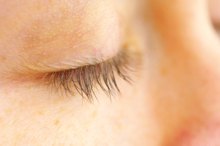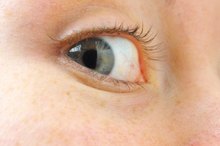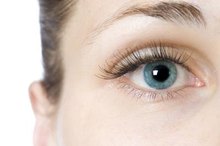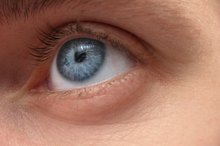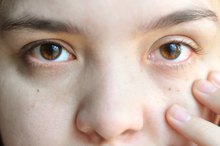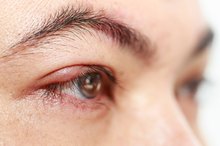What does fact checked mean?
At Healthfully, we strive to deliver objective content that is accurate and up-to-date. Our team periodically reviews articles in order to ensure content quality. The sources cited below consist of evidence from peer-reviewed journals, prominent medical organizations, academic associations, and government data.
The information contained on this site is for informational purposes only, and should not be used as a substitute for the advice of a professional health care provider. Please check with the appropriate physician regarding health questions and concerns. Although we strive to deliver accurate and up-to-date information, no guarantee to that effect is made.
Redness on Eye Rim
The eye rim, or eyelids, can become red for many reasons. Each of the reasons indicates either an infection or sterile inflammation of that tissue.
If you are experiencing serious medical symptoms, seek emergency treatment immediately.
When the eye rim becomes red, it will generally also be irritated and sore. Four of the most common possibilities for the cause of red eyelids are blepharitis, meibomitis, a hordeolum or cellulitis 3. These conditions can be irritating to have, and one of them can become a potentially sight-threatening condition.
Blepharitis
According to the American Optometric Association, blepharitis is a condition where the eyelids become inflamed 1. They turn red and become irritated, and they develop flakes of matter discharge that accumulate on the eyelashes. This condition is not contagious. It is most commonly caused by an overgrowth of one species of the many species of bacteria that normally live on our bodies.
This condition can be treated with over-the-counter remedies such as washing the eyelids with baby shampoo or a commercially available eyelid hygiene pad. It can also be treated with antibiotic eye drops, ointments or pills that are available by prescription only.
- According to the American Optometric Association, blepharitis is a condition where the eyelids become inflamed 1.
Meibomitis
White Pimple on the Eye Lid
Learn More
Optometric Management describes meibomitis as a condition that affects the oil glands in our eyelids, causing dry eyes. These glands secrete oil to keep a film of tears moistening the eye. If the oil production is disrupted, the glands will become clogged. This causes the eyelids to become swollen and irritated.
**It also causes the eyes to become dry.
** Meibomitis can be caused by environmental factors, hormonal changes, medications and blepharitis. Treatment for this condition can include over-the-counter remedies such as hot compresses, fish oil or flax seed oil supplements, or prescription medications such as oral antibiotics.
- Optometric Management describes meibomitis as a condition that affects the oil glands in our eyelids, causing dry eyes.
Hordeolum
A hordeolum is also known as a sty. According to the Mayo Clinic, a hordeolum is an infected oil gland in the eyelid 23. It will appear as a pimple or boil with a white head on the edge of the eyelid near the eyelash follicles. These can be extremely painful.
They are generally caused by poor eyelid hygiene and ongoing blepharitis or meibomitis.
However, they can develop even in the absence of blepharitis or in the presence of good hygiene.
A hordeolum is generally treated by hot compresses and digital massage. They may need to be drained by an eye care provider such as an optometrist or an ophthalmologist. An antibiotic ointment, and sometimes an antibiotic pill, are generally prescribed to fight the infection. An untreated hordeolum can develop into cellulitis 3.
- A hordeolum is also known as a sty.
- A hordeolum is generally treated by hot compresses and digital massage.
Cellulitis
Itchy Eyelash Follicles
Learn More
The Mayo Clinic describes cellulitis as a potentially dangerous skin infection that is caused by bacteria 23. Cellulitis of the eyelid is called pre-septal cellulitis 3. This condition can start as a red eye rim, but it quickly develops the appearance of a black eye. This can develop from a break in the skin that allows bacteria to enter the area. **An untreated hordeolum is a perfect example.
** Pre-septal cellulitis that is untreated can develop into orbital cellulitis 3.
This condition can cause a person to lose an eye. The treatment for pre-septal cellulitis involves the use of powerful antibiotic pills, and sometimes the addition of an antibiotic ointment 3.
- The Mayo Clinic describes cellulitis as a potentially dangerous skin infection that is caused by bacteria 2.
Bottom Line
Redness on the eye rim can come from many different sources. Many of them are no more than a minor inconvenience.
Some of them can develop into a more serious problem, and some of them represent an immediately serious problem. If a person has any persistent redness of the eye rim, they need to see their optometrist or ophthalmologist for the proper diagnosis and treatment.
- Redness on the eye rim can come from many different sources.
- Some of them can develop into a more serious problem, and some of them represent an immediately serious problem.
Related Articles
References
- American Optometric Association: Blepharitis
- Mayo Clinic: Hordeolum
- Mayo Clinic: Cellulitis
- Raff AB, Kroshinsky D. Cellulitis: A review. JAMA. 2016;316(3):325-37. doi:10.1001/jama.2016.8825
- Brown BD, Hood Watson KL. Cellulitis. [Updated 2019 Nov 6]. In: StatPearls [Internet]. Treasure Island (FL): StatPearls Publishing; 2019 Jan-.
- Gunderson CG, Martinello RA. A systematic review of bacteremias in cellulitis and erysipelas. J Infect. 2012;64(2):148055. doi: 10.1016/j.jinf.2011.11.004.
- Elahi M, Sanchez PJ, Alqudah E, Antonara S. Invasive Haemophilus influenzae infections in children: A 10-year study. Open Forum Infect Dis. 2018;5(Suppl 1):S687. doi:10.1093/ofid/ofy210.1967
- Sullivan T, de Barra E. Diagnosis and management of cellulitis. Clin Med (Lond). 2018;18(2):160–163. doi:10.7861/clinmedicine.18-2-160
- American Academy of Dermatology. Cellulitis. 2018.
- Gunderson CG, Martinello RA. A systematic review of bacteremias in cellulitis and erysipelas. J Infect. 2012 Feb;64(2):148055. doi: 10.1016/j.jinf.2011.11.004.
- Habif, T. Bacterial Infections. Clinical Dermatology, 4th Edition. New York: Mosby, 2004: 236-262.
- Halpern, A., and Heymann. W. Bacterial Diseases. Dermatology. 2nd Edition. New York: Mosby, 2008: 1075-1084.
- Morris JG. Vibrio vulnificus infections. Calderwood SB, ed. UpToDate. Waltham, MA: UpToDate Inc.
Writer Bio
Travis Sharpe began writing in 2009. His articles appear on eHow and Answerbag, where he specializes in eye health, general health and prescription medications. Sharpe is a Fellow of the American Academy of Optometry (AAO) and graduated summa cum laude from his alma mater. He has a Doctor of Optometry from the Southern College of Optometry.
